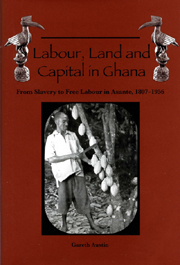Book contents
- Frontmatter
- Contents
- List of Illustrations
- List of Tables
- Preface
- Note on Names
- Maps
- Note on the Maps
- 1 Introduction
- Part I Context and Concepts
- Part II Social Relations of Production and Trade, 1807–1896: Absent and Imperfect Factor Markets
- Part III Slavery as Hobson's Choice: An Analysis of the Interaction of Markets and Coercion in Asante's Era of ‘Legitimate Commerce’, 1807–1896
- Part IV The Decline of Coercion in the Factor Markets of Colonial Asante: Cocoa and the Ending of Slavery, Pawnship and Corvée, 1896–c.1950
- 11 Why Was Prohibition So Long Delayed? The Nature and Motives of the Gradualism of the British ‘Men on the Spot’
- 12 The Decline of Coerced Labour and Property in Persons in Practice: Change from Above and from Below in Colonial Asante, 1896–1950
- 13 Cocoa and the Ending of Labour Coercion, c.1900–c.1950
- Part V Social Relations of Production and Trade, 1908–1956: Towards Integrated Factor Markets?
- Part VI Freedom and Forest Rent, 1908–1956
- Abbreviations Used in the Notes
- Notes
- List of References
- Index
13 - Cocoa and the Ending of Labour Coercion, c.1900–c.1950
from Part IV - The Decline of Coercion in the Factor Markets of Colonial Asante: Cocoa and the Ending of Slavery, Pawnship and Corvée, 1896–c.1950
Published online by Cambridge University Press: 12 September 2012
- Frontmatter
- Contents
- List of Illustrations
- List of Tables
- Preface
- Note on Names
- Maps
- Note on the Maps
- 1 Introduction
- Part I Context and Concepts
- Part II Social Relations of Production and Trade, 1807–1896: Absent and Imperfect Factor Markets
- Part III Slavery as Hobson's Choice: An Analysis of the Interaction of Markets and Coercion in Asante's Era of ‘Legitimate Commerce’, 1807–1896
- Part IV The Decline of Coercion in the Factor Markets of Colonial Asante: Cocoa and the Ending of Slavery, Pawnship and Corvée, 1896–c.1950
- 11 Why Was Prohibition So Long Delayed? The Nature and Motives of the Gradualism of the British ‘Men on the Spot’
- 12 The Decline of Coerced Labour and Property in Persons in Practice: Change from Above and from Below in Colonial Asante, 1896–1950
- 13 Cocoa and the Ending of Labour Coercion, c.1900–c.1950
- Part V Social Relations of Production and Trade, 1908–1956: Towards Integrated Factor Markets?
- Part VI Freedom and Forest Rent, 1908–1956
- Abbreviations Used in the Notes
- Notes
- List of References
- Index
Summary
This chapter examines the hypothesis that the demise of previously widespread property rights in people was the result, not only of changes in law and its implementation, but also in the economy. In the period of ‘abolition’ in Asante, as in the Gold Coast before it, the principal economic change was the adoption and spread of cocoa-farming.
That cocoa began to be adopted before slavery was made effectively illegal makes it interesting to examine the ending of Asante slavery as a possible case of induced institutional innovation. Can it be explained as a response to a shift in relative factor prices which made it socially efficient for the property rights regime to be changed to accommodate the new economic circumstances? The spread of cocoa-farming altered the relative scarcities of labour, land and capital: and this was reflected, implicitly and explicitly, in changes in relative factor prices. Did this shift contribute to the end of slavery in Asante? A ‘Third World’ parallel, to judge from David Feeny's account, would be nineteenth- and early twentieth-century Thailand, where he sees a transition from rights in people to rights in land as land became less abundant. Section A asks whether the concept of induced innovation can help to explain why, after waiting twelve years, the British finally introduced prohibition. In tackling that question evidence is provided about the impact of abolition on cocoa farming.
- Type
- Chapter
- Information
- Labour, Land and Capital in GhanaFrom Slavery to Free Labour in Asante, 1807–1956, pp. 236 - 250Publisher: Boydell & BrewerPrint publication year: 2005

